October
2003 was a very exciting month.
Peter Johnsson was here in New Glarus for the second time that year.
We were introducing new models to the Next Generation line
and going over future models.
When Peter is in town, it is always a whirlwind of activity. A lot
of information is shared all at once -- it is like drinking from a
fire hose. This sharing of information makes it into a sword geek's
dream.
Most Albion staff would say that it is a bit difficult to concentrate
on work when Peter is here, but it was especially difficult
for me.
You see, in just a few weeks, I would be joining Peter on his flight
back to Sweden. The purpose: to document and handle original swords
in museums -- for me, it would be the first time I wouldbe allowed
into the store room and actually handle an original, not just leaving
noseprints on the display glass.
I was beside myself with excitement. Time seemed to move very slowly.
After many days of very involved design work with Steve, our CAD designer,
discussions with Jason on new blades and heat-treating issues, and
discussions with Howy on the next round of new models, the big day
finally arrived.
My wife and children accompanied us to O'Hare Airport in Chicago.
After saying goodbye to my family, we boarded our plane.
It is 9 hours to Sweden. You can make it in 8.5 if the jet stream
gives you a strong tailwind. I flew in the Air Force, so there is
something in me that says "don't go to sleep" when I fly. Even so,
I tried to sleep. It would be early morning when we arrived in Sweden,
so I knew I had a whole busy day ahead of me.
Sleep never came. My mind was reeling.
I imagined over and over the treasures I was going to see. In my mind,
I pictured myself holding a medieval sword as Peter explained all
of the intricate details of the piece. I thought that if I could handle
just one good medieval sword that this trip would be a huge success;
I had no idea that this simple expectation would be completely blown
out of the water.
It was a crisp sunny morning when we arrived in Stockholm. We boarded
a bus that took us to Peter's hometown of Uppsala.
To me, Uppland looks a lot like Wisconsin -- rock formations and farmland.
I was immediately smitten by the place.
For the first few days, I had the pleasure of helping Peter in his
smithy. This was great! I got to see Peter at work in his natural
habitat.
We were making pieces for a display in the new post office building
- when construction workers dug the foundation, they unearthed a seax,
spear head, fire starter and buckle. I guess that sort of thing happens
a lot in Europe. The post office asked Peter to make recreations of
the pieces for public display.
After many hours of work, the post office projects were completed
at last, and the big day finally arrived -- we were going to see originals!
Day One
Our first stop was Husbyborg. This is the store room for the University
of Uppsala, Archeology Department.
We checked in at the security desk and were met by one of the university
staff members who led us into the climate controlled store rooms.
I had envisioned a few swords in a display case, but what I saw blew
me away.
There was a room full of large shelves with hundreds of swords, knives,
and axes laying on them. On the other side of the room were drawers
filled with items from different find sites throughout Sweden.
I was awestruck.
I was literally allowed to handle anything I wanted to handle (with
white gloves on of course). I was in a wonderland of Viking and medieval
weapons. There were so many that, like the children in the Willy
Wonka film, I had a hard time choosing what to handle first.
We began with Viking swords, about 30-40 of them. Some of them were
quite corroded, but most were in good condition. While they were all
definitely Viking swords, I was amazed at the diversity. There were
quite a few Type H hilted swords, though many other hilt types were
also present.
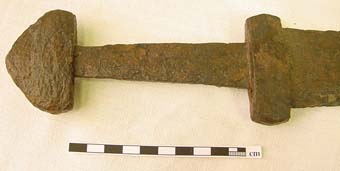 |
|
The
narrow Geibig Type 1
(click for larger image)
|
One that really stood out was this narrow bladed Viking sword -- I
believe it was of the Geibig 1 type blade. It had a really nice compact
feel about it.
Another that made an impression was a type H that had a complete pommel.
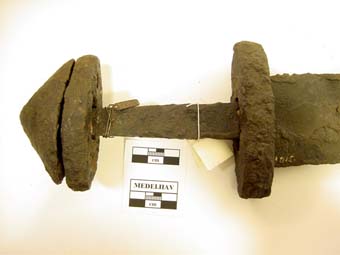 |
|
Type
H hilt
(click for larger image)
|
The pommel was not attached, so you could take it apart and view the
construction of the piece.
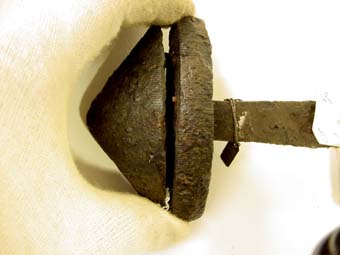 |
|
Type
H pommel detail
(click for larger image)
|
After several hours handling sword after sword, we picked about 6
or 7 that we wanted to document and placed them on the cart to take
to the study room.
We then began to look at the medieval swords.
There were some incredible swords in the collection. We must have
looked at about 2 dozen of them including a rather attractive Oakeshott
type XII with a faceted spherical pommel. It was a small sword but
it had a presence about it.
|
|
|
The
Type XII with faceted pommel
(click for larger image)
|
In addition there were several X's and a Xa which caught our eye.
So, we pulled those off the shelf and load them on the cart.
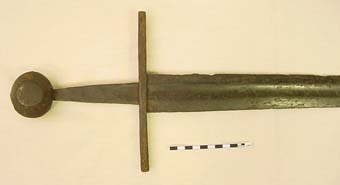 |
|
The
Type Xa
(click for larger image)
|
In the study room, we began the process of documenting these swords.
We split up the responsibilities to make the best use of our time.
I was to photograph each piece and Peter would trace them and take
measurements. It was an ambitious goal but we were going to document
all of these swords in two days.
I knew that documenting a sword was intense, detailed work -- however,
it is even more involved than I knew!
One is tempted to view it merely as tracing a sword on paper, but
that is only a small fraction of the work. To do a thorough documentation,
precise measurements need to be taken. These measurements are critical
to making an accurate recreation. In addition, photos need to be taken,
from many different angles and distances, that will verify and illuminate
basic aspects and special features of each sword.
Without help, it could take Peter 3 or more hours to document a basic
sword - much longer if the sword is complex.
We worked quickly and efficiently for the better part of a day. When
it was time to leave, we asked if we could come back to continue the
next day. Having secured a return visit, we went back to Peter's apartment.
I was exhausted.
I fell asleep that night thinking about our day. I dreamt about the
people who would have owned those swords. What were they like? What
happened to them? Who made their sword? I felt like a young boy again
-- a young boy on a big adventure.
|
|
Day Two
On the previous day we had left those swords that we still needed
to document on the table. Peter asked me to go in the store room to
find some axes and spear heads to document while he got started making
tracings.
Eagerly, I went into the store room and began to open the drawers
that contained the smaller items.
I was alone in this storeroom! It was almost more than I could
handle.Just me -- the geeky kid from Indianapolis -- and some of the
world's hidden treasures.
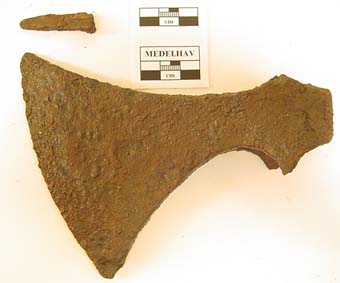 |
|
A
Viking axe
(click for larger image)
|
Carefully I opened drawer after drawer. I pulled out some of the best
axe heads, made a note of where they came from, and placed them on
the cart.
I found some rather nice spearheads, too.
One in particular stood out. It was a beautiful silver gilt spearhead
with wonderful engravings that were filled with niello. It was stunning!
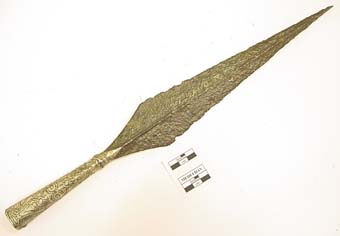 |
|
Silver
gilt spearhead with niello
(click for larger image)
|
I took these items into Peter, and told him he should come back and
look at some of these other items. He took a break and followed me
into the store room. While he was viewing these items, I climbed up
the ladder to view the top shelf of one of the sword racks.
My eye caught a glimpse of not one but two swords with spherical pommels.
I called Peter over and he climbed up the later. He exclaimed, "Be
still my heart!"
Peter carefully removed a rather large warsword with a hollow ground
blade and spherical pommel.
|
|
|
The
hollow-ground warsword
(click for larger image)
|
After he handed this monster to me, he removed another sword that
had lost the lower third of the blade. It too had a spherical pommel
and a rather attractive guard.
We quickly took them to the study room for a closer look.
The hollow ground sword was massive -- clearly a two-hander. Even
though it was hollow ground, it must have weighed nearly 2 kilos!
|
|
|
The
hollow-ground warsword hilt
(click for larger image)
|
The guard was not very attractive, but the ends had stylized animal
heads filed into them.
|
|
|
A
detail of the hollow-ground warsword hilt
(click for larger image)
|
The pommel was more oval (I would still count it as a spherical pommel),
and its weight gave this massive sword a rather lively feel.
Overall, this was a very impressive sword. We were thrilled with this
discovery. At one point, the administrator came by the table and exclaimed,
"I didn't know we had that sword, where did you find it?" After
handling it, he was quite impressed too.
The other sword with the spherical pommel was even more impressive.
It was missing the first third of its blade but the hilt was in good
condition. The pommel was almost perfectly spherical and there was
evidence of some sort of rivet block or rosette at the top. The guard
was very impressive. It was octagonal in shape with trumpeted ends,
but the line of each arm was interrupted by a small beveled swelling.
|
|
|
The
sister sword to the Tritonia
(click for larger image)
|
As we examined the sword in detail, it became obvious to Peter that
he had previously documented a sword of similar proportions: the Tritonia.
|
|
|
The
sister sword to the Tritonia
(click for larger image)
|
Once we got home that night, we were able to place a prototype Tritonia
on the drawing of the Husbyborg sword, and it was almost an exact
match!
As we sat in Peter's living room, drinking fine Scotch and looking
over our day's work, Peter said, "I think it is very possible that
the person who made Tritonia, made this sword, too. The proportions
are very close, and what is the chance that two swords of nearly equal
proportions would be found within 50 kilometers of one another? These
two swords had to come from the same workshop."
All I could do was smile.
Over those glorious two days, I was able to handle an ancient Egyptian
bronze dagger, several bronze swords, 4-5 Vendel era swords and seaxs,
over two dozen Viking swords, half a dozen Viking axes, half a dozen
Vendel and Viking spearheads, 15 medieval swords and countless buckles,
chapes and other items of interest.
If that wasn't enough, discovering those two swords on that top shelf
was the icing on the cake...
For a sword geek, these two days were a dream come true. Husbyborg
will always be a very special place to me.
|

